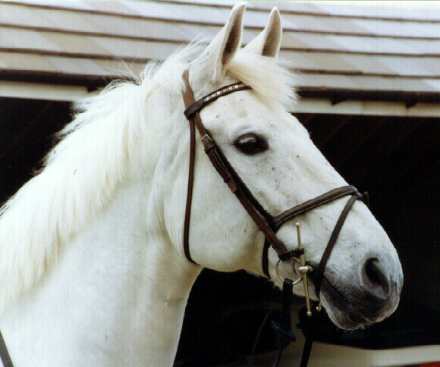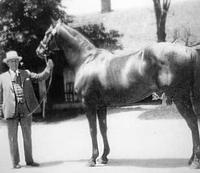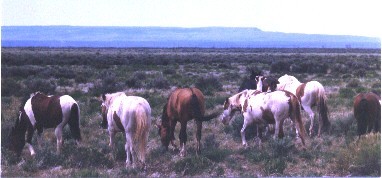Everest/Next Milton
Height: 16.2hh
Colour: Grey
Sex: Gelding
Breed: Dutch Warmblood
Sire: Marius
Grand-Sire: Marco Polo
Rider: John Whitaker
Owner: Mr and Mrs. Bradley
Milton was bought as a foal by young showjumper, Caroline Bradley. Caroline trained and rode Milton up until she tragically died. Her parents, in wanting to see their daughters horse succeed as she would have wanted him to, approached John Whitaker about riding their talented grey. It was with John Milton became what he was, a showjumping legend, partnering John from 1985 to 1994.
He was everyone's favorite and loved all over the world. The talented grey oozed presence. When he entered the ring crowds would raise the roof with their cheers. He is quite possibly the most famous and loved showjumper of all time. Milton passed away on Sunday the 4th of July and is buried at the Whitaker farm in Yorkshire where he lived since 1985.

Major Achievements
Milton was the first horse ever to accumulate winnings of over £1million.
Won team bronze and individual silver at the World Championships at Stockholm
Throughout his whole career he hardly ever knocked or refused a fence in his career.
Won FEI World Cups 1990 and 1991
team gold medals European Championships 1987 and 1989
Individual gold 1989 European Championships
Individual silver 1990 World Championships
Man O' War

Just before midnight on March 29, 1917 Mahubah foaled a beautiful
chestnut colt now known as Man O' War. The entry in the Nursery
Stud daybook was written as follows:
Mch 29, 1917-- Mahubah foaled ch colt by Fair Play. Star, narrow
stripe from right of star down center of nose. Height: 42 Girth:
33
Man O' War's mother, Mahubah, meaning "may good things be with
you" had a sweet disposition that was inherited by her father,
Rock Sand, winner of Great Britain's Triple Crown. His father,
Fair Play, was a large, powerful horse, but was just as
temperamental as his father, Hastings.
In 1918, Major Belmont decided to sell all his yearlings,
something he had never done before.
On Saturday, August 17, 1918 all of the yearlings went to
Saratoga. Famed horse owner Samuel D. Riddle bought Man O' War
for $5,000, while the average price for the yearlings was $1,107.
Because of his red hair, he was often called "Red", but when he
grew over 16 hands, his nickname was changed to "Big Red".
Feustel began the chore of breaking "Red" when they arrived at
Glen Riddle Farm in Pennsylvania. Feustel recalls saying
"Mahubah's colt, He was a tough horse to break, a tough horse to
saddle."
In the spring of 1919 Man O' War was trained at Havre de Grace
and Pimlico.
On June 6, 1919 the young colt made it to the racetrack, in a
maiden race at Belmont Park. His odds were 3-5. This race was
five furlongs long, in which he ran in :59 seconds, winning by
six lengths.
Man O' War was a legend before finishing racing in October. There
had been a discussion for a long time, which was: Who was the
greatest horse of the century- Colin or Sysonby? That was not a
question anymore, Man O' War was the best.
During the sixteen months between June 1919 and October 1920, Man
O' Was literally rewrote the record books. His record included:
Dwyer Stakes- 1 1/8 miles (World Record)
Belmont Stakes- 1 3/8 miles (World Record)
Lawrence Realization- 1 5/8 miles (World Record)
Jockey Club Stakes- 1 ½ miles (American Record)
Wither Stakes- 1 mile (American Record)
Kenilworth Park Gold Cup- 1 ¼ miles (Track Record)
Potomac Handicap- 1 1/16 miles (Track Record)
Travers Stakes 1 ¼ miles (Equaled Track Record)
Man O' War won the Belmont Stakes by 20 lengths and the Lawrence
Realization by an astounding 100 lengths.
This horse had 21 starts and 20 wins. The single blemish on Man
O' War's track record was the Sanford Stakes. He was turned
sideways when the mash barrier went up, causing him to place
second in the race.
This phenomenal colt retired as the greatest money-winning
thoroughbred ever. $249,465 (which was at that time a record)
23 years as a stallion, he produced 64 stakes winners, including
War Admiral. The Fillies he sired became wonderful brood mares
who produced 164 stakes winners.
On November 1, 1947, at age 30, Man O' War died of natural causes
at Faraway Farms. He will always be the greatest thoroughbred of
the 20th century and the millennium.
Seabiscuit

The Story of The Horse, America Fell In Love With
In the latter half of the Depression, Seabiscuit,
an undersized and crooked-legged horse, had become a
household word in America.
He was adored by fans, his appearances breaking attendance
records at nearly every major racetrack. There was even
a special cross-country train named "Seabiscuit Limited"
that shuttled fans to his races.
His four-year rise in the world of racing was one of
the most notable and widely followed struggles in sports
Back in the 1930's the realities of the Great Depression
had driven deep into most men's hearts. At the time the
average American worker was earning about $500 a year.
At least those who were fortunate to find work.
Times were hard, there was little to cheer about.
Adolph Hitler was in the news and everyone knew
trouble was brewing in the world.
Ten years of hardship had just passed, the hardest
economic times in our history. Americans needed something.....
something that they could relate to, something that they
could find hope in.....something that would give
them encouragement.
Encouragement....hope.....faith, that the little guy
could pull out of this depression and make a go of it,
that men who were formerly down and depressed could
come from behind and make a decent life for himself
and his family.
America found it's hero in a rather unique form.
A horse named Seabiscuit.
He had short legs, asymmetrical knees that didn't

quite straighten all the way giving him a crouching Seabiscuit & War Admiral
stance and an odd, inefficient "eggbeater" gait
that one writer likened to a duck waddle.
No one ever thought Seabiscuit would amount to much,
his career had been noteworthy only in its appalling
rigor.
Seabiscuit was a horse that no one really wanted.
Yet, he had something inside of him that was inherited
from his grandfather, the immortal racehorse,
Man O' War. That something was a tenacity, a bull dog
determination, a spirit of winning.
With that spirit and the determination and patience
of his owner, trainer and jockey, Seabiscuit began
his rise to fame and fortune.
Seabiscuit was something that folks could relate to.
Something that had been given little chance of ever
succeeding, something that had a lot of problems
and adversity to overcome.....Seabiscuit was now
the little guy who came from behind and beat the odds.
Seabiscuit gave people hope. Hope that they too could
come from behind and win in life.
In 1937 Seabiscuit garnered more newspaper column
than Hitler, Mussolini, Roosevelt, Churchill, or any
other public figure. He had won 10 major events, broken
5 track records and taken in the most winnings of
any race horse that year....yet he was not named
Horse of the Year
An eastern black beauty that had won the Triple Crown
named War Admiral was instead, picked as Horse of the Year.
But, Seabsicuit was rapidly becoming the heart throb
of America. His owner, Charles Howard was a worthy
salesman who knew how to "play the press" ...
America soon clamored for a match up.
On November 1, 1938 the two horses went head to head
on a small race track that held just 16,000 seats.
By race time there were 30,000 fans in the stands
and another 10,000 in the infield. The rest of
America virtually shut down to listen to the broadcast.
Even President Roosevelt delayed a press conference
to listen.
It was no contest. Seabiscuit hit the finish 4 full
lengths in front and had ran the race in near world
record time.
The little horse from nowhere, the little guy with
the wobbly gait, the horse nobody wanted, beat War Admiral,
the big strong guy with all the right moves and with
the big money behind him.....Seabiscuit had become the
long shot that captured America's hearts.
By the end of 1938, Seabiscuit had won 33 races,
set 16 track records and equaled another. He was
literally worth his weight in gold, having earned
a world record $437,730, nearly 60 times his purchase
price.
With the looming war in the papers, America now
had something they could relate to, something that
gave them the hope and determination they needed
to understand and know they could survive whatever
would soon come and know that they could come out
of the Great Depression on top and victorious.
After his racing days were over, Seabiscuit spent
his time lounging around the pasture, herding
cattle, and greeting some 50,000 fans who came
to see him.
On May 17, 1947 America lost one of it's heroes.
Seabiscuit had died at only 14 years of age from a
heart attack. He was buried in a secret spot on
Mr. Howard's ranch with only an oak tree planted
over his grave as a memorial.
Seabiscuit
Born: 1933
Died: 1947
Trainer: Tom "Silent Tom" Smith
Owners: Charles & Marcela Howard
Jockeys: Red Pollard & George "The Iceman" Woolf
"Horses stay the same from the day they are born until
the day they die... They are only changed by the way
people treat them."
Little Sorrel
Little Sorrel
Little Sorrel, or "Fancy" as he was known, became famous as the mount of General Stonewall Jackson. Captured at Harpers Ferry by the Confederates, he was chosen initially for Mrs. Jackson but eventually commandeered by the General when his own horse, Big Sorrel, proved unreliable in battle.
In 1863, at Chancellorsville, Jackson, while riding the horse, was wounded by his own men and died a few days later. At first Little Sorrel was pastured at Mrs. Jackson's home in North Carolina, later sent as a mascot to the Virginia Military Institute where the General had taught cadets he led to battle, and then in response to requests from many Southern States, was shown at fairs and exhibitions.
In 1885, ancient and infirm at the age of 35, he was retired to the Confederate Soldier's Home. The following year he died when the hoist used to lift him to his feet slipped; he fell breaking his back. Little Sorrel was stuffed and housed in a museum at the Veterans Home until 1949 when he was finally returned to V.M.I. Refurbished twice since 1886, Little Sorrel is presently on display at the Virginia Military Institute's Museum in Lexington, Virginia
Pre-History of the horse
The evolution and development of North American eco-systems definitely included horses! 25,000 year old frozen remains of horses identical to today's wild horses have been found in the Arctic Tundra.
Horses are generally believed to have become extinct in their land of origin about 8000 - 10,000 years ago - probably at the hands of the first human immigrants (if it ever could be proved that even one tiny pocket of original horses remained, it would make legal protections for this species so much easier - but so far, there is no such evidence).
North America was the original home of the horse species. They evolved here, and thrived here for millions of years. The plant and animal communities of North American ecology evolved with horses playing an integral role. About 8,000 - 10,000 years ago (coinciding with Human settlement) they became extinct i the land of their origin, although luckily by that time they had migrated to Asia, where they spread into Europe and North Africa.
It was long believed that the pre-extinction American horse was a more primitive form and not the true horse of today. But that changed in September of 1993, when some placer miners in the Yukon uncovered a horse and paleontologists were called in. Initially, nobody thought too much about the well preserved, brownish red horse in the permafrost layer.
It didn't look different from any other horse that had died and been buried in the mud. Even the stomach contents were still in the gut, and the flaxen mane hung over the neck of the hide covered skeleton. Scientists might have been looking at a near carbon copy of some of the smaller wild horses in the West. Analysis revealed it was about 25,000 years old! proving that the horse is a true native species.

